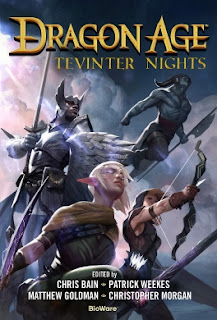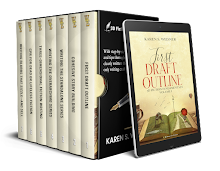{Put This One on Your TBR List}
Book Review: Dragon Age: Tevinter
Nights
Edited by Chris Bain, Patrick Weekes, Matthew Goldman, and
Christopher Morgan
by Karen S. Wiesner

Warning Spoilers!
Prior to Dragon Age: The Veilguard's release (which I reviewed last week and you'll probably want to refer back to in reading the reviews of these strongly connected individual tales), a new anthology of short stories was released in March 2020 called Tevinter Nights. As the name implies, all the stories are set in Dragon Age's Thedas, many directly in the Tevinter Imperium, where magic-wielding magisters rule and blood magic isn't forbidden. I bought the book (complete with a gorgeous, foldout, color map) at the time of its publication and read it, but since The Veilguard was still in development at that time (and wasn't even named that until later), I felt like I didn't understand where all the stories were coming from. Following the release of The Veilguard, I got it out again and started rereading it. With a much better understanding of all the things going on around the events of the new game, I enjoyed the stories immensely. In fact, it may be the only anthology collection that I enjoyed every single one of the stories included. The tagline of this collection really says it all: "Ancient horrors. Marauding invaders. Powerful mages. And a world that refuses to stay fixed… Welcome to Thedas." Dragon Age is everything I look for in the fantasy genre and then some.
In this collection, readers are getting a real treat with stories written by nine BioWare staff writers who really know the world contained in the Dragon Age franchise that includes but isn't limited to videogames, electronic games, books, comics, film and television, tabletop roleplaying games, and music. As I said last week, you might be interested in my previous review of all things Dragon Age, which is here: https://aliendjinnromances.blogspot.com/2022/11/karen-wiesner-fiction-series-so-big.html.
Below you'll find reviews of
every story in the collection. Be aware that a major plot angle in Dragon Age: The Veilguard videogame centers around
ancient Tevinter artifacts being stolen or unearthed in order to aid the evil
that wants to take over the world. So several of these short tales have that as
a major theme. Below, I've listed each story in the order they appear in the
original publication.
1. "Three Trees to
Midnight" by Patrick Weekes: At the time The Veilguard is set, there's a qunari invasion going on in Thedas
that's changing the world. This first story focuses on their capture of a Dalish
elf Veil Jumper named Strife (who's featured in the videogame along with
Irelin, a team-mate also in this story) and a mage named Myrion. Qunari deeply
distrust and put down mages, so Myrion has to hide his powers once he's
captured. He's chained to the elf Strife. Tevinter magisters treat elves as
nothing more than slaves. So there was a lot of "Enemy Mine" racial
prejudice in this this story as the two are forced to work together in order to
escape their relentless captors.
2. "Down Among the
Dead Men" by Sylvia Feketekuty: The Mourn Watch are the elite guardians of
the Grand Necropolis, reverently caring for the dead. They're also a faction of
a larger organization, the Mortalitasi.
In Inquisition, I was led to believe the
Moralitasi are all evil, but in The Veilguard,
I learned that's not always the case. We met one of their order, Emmrich, in Veilguard, along with his beloved
skeletal companion Manfred, and I was pleased to see them play a role in this
particular story in which a guardsman investigates a death in the Necropolis.
Very intriguing setting in both the game and this wonderful story with a twist
ending.
3. "The Horror of
Hormak" by John Epler: My
favorite part of Dragon Age has always been the Grey Wardens, those who give so
sacrificially in order to maintain a constant vigilance over the return of darkspawn
and potential Blights. This story has two Wardens investigating the
disappearance of a scouting party. This story is horror in its purest, most
intriguing form, and it was an instant favorite of mine.
4. "Callback" by Lukas Kristjanson: Dragon Age: Inquisition had an unmarked quest about
"Sutherland and Company" that was mainly followed through War Table
operations. If you didn't screw these up and prematurely end the venture, they
culminated in an actual crusade for the Inquisitor to save Sutherland and his band
of misfits. In this story, the Inquisition has disbanded but their headquarters
Skyhold is still maintained by caretakers that haven't been heard from in a
while. Sutherland and Company are sent by the Inquisitor to investigate. I
loved revisiting Skyhold and these uber-loyal, unlikely heroes.
5. "Luck in the
Gardens" by Sylvia Feketekuty: Another beloved Inquisition character, Dorian, makes an appearance in this fun
story in which a member of the Lords of Fortune (from The Veilguard) investigates a series of monster killings in
Minrathous.
6. "Hunger" by Brianne Battye: In The Veilguard, we're introduced to two
married Grey Wardens, Evka and Antoine. This story takes place while these new
recruits are traveling to report for duty at Weisshaupt Fortress. They're
sidetracked in a town cursed by mysterious and monstrous deaths. This was a
neat background to the roles these two end up playing in the videogame, and a
precursor to their romance.
7.
"Murder
by Death Mages" by Caitlin
Sullivan Kelly: Mortalitasi is the umbrella organization of "death
mages" in the Grand Necropolis that advise Nevarran nobility. The
Pentaghast family (re: Cassandra from Inquisition)
were some of the founders. Though the group is well-respected in Nevarra,
outside they're feared as a cult. The current ruler of Nevarra is aged and
weak, his sanity uncertain, and most believe the Mortalitasi are ruling through
him. Cassandra Pentaghast, one of the
Inquisition's inner circle, assigns a volunteer in the Inquisition to
investigate the death of a death mage. This Inquisition mage volunteer was
raised by and eventually abandoned this particular death mage, vowing never to
return to Nevarra. A Mortalitasi member is suspected of causing political
unrest in order to assassinate Nevarra's ruler. Both Cassandra and this investigator
have a lot at stake in seeing this situation resolved. While the point-of-view
character wasn't exactly lovable, with baggage that's made her bitter and
withdrawn, the story had an intriguing whodunit with a lot of complications to
keep it suspenseful.
8. "The Streets of
Minrathous" by Brianne Battye: Neve Gallus is one of the main companions
in The Veilguard, a member of the
Shadow Dragons, and a supernatural detective. In the videogame, her loyalty
quests all involve a Venatori agent, Aelia, who's trying to subjugate
Minrathous (isn't it ironic how often a tyrant calls it "freeing" a
population?). This story is the background to all of that--and it's also here
we find out what happened to the Templar Brom, something only referenced in the
videogame. I enjoyed this setup to a pivotal character in the game.
9. "The Wigmaker
Job" by Courtney Woods: Another inner circle Veilguard member, Lucanis
Dellamorte, is an Antivan Crow assassin. We learn much more of his background
in this story detailing a heist with his cousin Illario (also featured in the
videogame), which doesn't get into how Lucanis came to have a demon inhabiting
his body, which is a focus of the game.
10. "Genitivi Dies in
the End" by Lukas Kristjanson: The
Veilguard Lords of Fortune are included in this crazy, off-beat story that
I really don't even know how to describe beyond that a weird group containing a
bard, a brother in the Chantry, a qunari mage, and a writer take on qunari
Antaam (military) in order to steal some ancient elven artifacts. It seems they
did this for the sole purpose of their art--in other words, so they'd have
something exciting to write about for their ravenous fans to devour. Writers
will appreciate this literary escapade, highlighting the extreme lengths
authors will go to get a great story.
11. "Herold Had the
Plan" by Ryan Cormier: Two Lords of Fortune (one who recently lost his
adventuring partner Herold of four decades) stealthily steal an ancient
Tevinter relic that heals even the deadliest of wounds during a Grand Tourney.
Unfathomably, every knight in the arena is instantly on their tails. Before
long, they realize that their third partner-in-crime has stolen the tourney's
grand prize right off the grandstand--the legendary Celebrant greatsword. This
was a fun, thrilling story that had unexpected depth and heart at its core.
12. "An Old Crow's Old
Tricks" by Arone Le Bray: Lessef of the Antivan Crows fulfills the
contract to exact vengeance on those who murdered the Dalish elf clan Oranava.
This was a clever story that took a bit to coalesce and make sense, as it's
told mainly from the points-of-view of those about to be assassinated who
foolishly think they're invincible.
13. "Eight Little Talons" by Courtney Woods: This was probably my favorite in the collection. Here, the author has done an Agatha Christie, following the style of And Then There Were None. The eight major players that head the Antivan Crows are called "Talons" and the hierarchy is from Talon 8 being the lowest of them, to Talon 1 being the highest ranking. Along with their fellow Talons, #5 Talon Viago and #7 Teia (who are featured in The Veilguard) are called to a summit at the First Talon's island home to discuss the qunari and the security of their nation, Treviso. One by one, the Talons are picked off at this secluded meeting, each death re-enacting infamous Crow assassins of the past. This is an obvious statement that no other Crows are safe. In this location, the killer is either hiding somewhere on the island or it's one of their own. (Intriguing--Crows hunting Crows.) Viago and Teia investigate. I loved both of these well-drawn characters, and their obvious attraction to each other sets the stage for their compelling banter in the videogame.
14. "Half Up Front" by John Epler: Another Tevinter artifact--Dumat's Folly (a puzzle that needed to be solved in the Dragon Age II DLC Legacy)--has been stolen. A thief is hired to find out who stole it from the Chantry and why--and to steal it back. The events in this tale directly play into the videogame, which really adds more dimension to that story, since this artifact is one that's integral to Solas/Fen-Harel's ultimate plan. I will also note that the story reminded me a lot of the events in the manga TV miniseries, Dragon Age: Absolution, which aired on Netflix in December 2022 and takes place around the time of The Veilguard. In Absolution, the Inquisition employs two members of the Absolution team, one of them its agent Fairbanks, who was a freedom fighter that asked the Inquisition to reclaim his home, the Emerald Graves. None of the other characters in the miniseries are recognizable, to me anyway. (The voices are very familiar for those who play videogames though.) While I really can't stand anime and manga and therefore I had a lot of trouble getting through even three of the six episodes available in the first season, there were some fun moments in the early episodes and the overall story had a really good twist I didn't see coming (I read a summary of the final episodes rather than forcing myself to watch them). Fans of the series that enjoy anime or manga would probably get much more out of Absolution than I did. Suffice it to say that the story in Absolution paralleled a lot of what was in "Half Up Front", almost too closely. At first, I even though they were the same characters from one to the other, though they weren't. In the end, I felt like one of these was redundant, as they're so similar as to be the same story. I believe "Half Up Front" is probably the most valuable, as it points directly to events in The Veilguard.
15. "The Dread Wolf
Take You" by Patrick Weekes: "May
the Dread Wolf take you" is an old Dalish curse that gives this story
even more meaning. The main character, Charter, was one of Leliana's top spies
from Dragon Age: Inquisition. In this
story, she's called together a clandestine meeting of Thedas's top spies in
order to share information about Solas and his plans to restore the ancient
elven empire by tearing down the Veil. In this secret place are a Carta
assassin, a Moralitasi, an "Executor" from across the sea, and an
Orlesian bard. Each tells a piece of the tale, and it becomes clear that the
target for each of their encounters with Solas was the red lyrium idol that was
the cause of destruction in Kirkwall in DA II.
Little does Charter realize that the cloak-and-dagger meeting has an unexpected
guest! I read this story all but holding my breath. I couldn't identify any of
the characters other than Charter, but it was very clear that this was the setup
for events (and even some of the pivotal settings) about to unfold in The Veilguard.
For anyone following my reviews of short story collections and my philosophy about how short story collections should be arranged, I think the editors did a fantastic job of exactly placing every story in Tevinter Nights in the order needed for optimal reading. The slightly weaker stories are wonderfully anchored and buoyed by the stronger ones with the strongest ones as the first, last, and middle.
In one sense, Tevinter Nights may not be a good introduction into the world explored in the Dragon Age series, since a lot of the material requires a bit of understanding in how the world of Thedas is run, the crucial events, etc. But, in another, these are just well-written, slice of life stories, a lot of which include magic, mages, mysteries, monsters, and intricate political machinations. Even if you're not familiar with DA lore, there's still lot to love here and, if you're ultimately lured in by these compelling tales, there's so much more to explore in this expansive realm.
Karen Wiesner is an
award-winning, multi-genre author of over 150 titles and 16 series.
Visit her website here: https://karenwiesner.weebly.com/
and https://karenwiesner.weebly.com/karens-quill-blog
Find out more about her books and see her art here: http://www.facebook.com/KarenWiesnerAuthor
Visit her publisher here: https://www.writers-exchange.com/Karen-Wiesner/





































